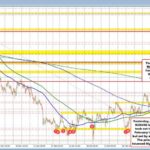
Goldman Sachs Adjusts Economic Forecasts: What It Means for USD and EUR/USD
Tháng 4 8, 2025
NZDUSD Recovery: Navigating Market Volatility and Future Trends
Tháng 4 8, 2025The Offshore Chinese Yuan: Navigating Record Lows Amid Escalating U.S.-China Trade Tensions
Understanding the Decline of the Offshore Chinese Yuan
Recent fluctuations in the offshore Chinese yuan (CNH) underscore significant economic challenges and strategy from Beijing in response to ongoing trade tensions with the United States. The yuan has plummeted to unprecedented lows, a move that is alarming to analysts who interpret it as a potential tactical devaluation by China. This depreciation appears aimed at cushioning the financial blow from the series of tariffs imposed by the U.S. on Chinese imports, which have been a cornerstone of the trade conflict between the two economic giants. The implications of these currency movements extend far beyond simple exchange rates; they affect global market stability and economic expectations for both countries.
Trade Tensions Escalate: A Catalyst for Economic Anxiety
The backdrop to this currency volatility is marked by a significant escalation in trade tensions between the U.S. and China. The ongoing conflict has been characterized by a tit-for-tat imposition of tariffs, with each nation leveraging economic policies as a means to exert pressure on the other. Recent announcements from the U.S. threatening additional tariffs have prompted a vigorous response from China, including vows to retaliate with countermeasures. This fervor in economic policy not only threatens the bilateral relationship between the two nations but also sends ripples through global markets, as investors react to the potential for increased costs and reduced trade flow. Notably, China’s President Xi Jinping convened over 40 top global CEOs to address these escalating tensions, emphasizing the need for international stability as a strategic move to fortify China’s position in global trade amidst these challenges. Learn more here.
Market Reactions: Panic Selling and Economic Intervention
The impact on the stock market has been pronounced, particularly within China, where significant panic selling has resulted in steep declines in major stock indices such as the Hang Seng and CSI 300. These movements are indicative of broader investor anxiety regarding China’s economic outlook and the effectiveness of government interventions. The Chinese government is reportedly turning to economic stimulus measures, possibly seeking to front-load such efforts in anticipation of worsening conditions. This may include deploying state-backed funds aimed at stabilizing market volatility and restoring investor confidence.
In conjunction with these stimulus measures, the strategic depreciation of the yuan is designed not only to counteract the effects of U.S. tariffs but also to bolster China’s export competitiveness. By making its goods cheaper on the global market, China aims to mitigate revenue losses stemming from decreased demand due to tariffs. Nevertheless, the economic calculus behind these actions is complex, as excessive currency depreciation can lead to inflationary pressures domestically, impacting consumer spending and overall economic health.
Conclusion: A Prolonged Conflict with Global Consequences
The intersection of a weakening offshore Chinese yuan and escalating trade tensions signals a concerning trajectory for both China and the U.S. As each country braces for potential long-term impacts from their respective policies, the risk of a protracted trade conflict looms large. With global markets closely watching these developments, the imperative for both nations will be to seek avenues for dialogue and constructive engagement to mitigate risks and restore stability. The outcomes of these interactions will not only shape the economic landscape in Asia but will resonate throughout the global economy for years to come.

